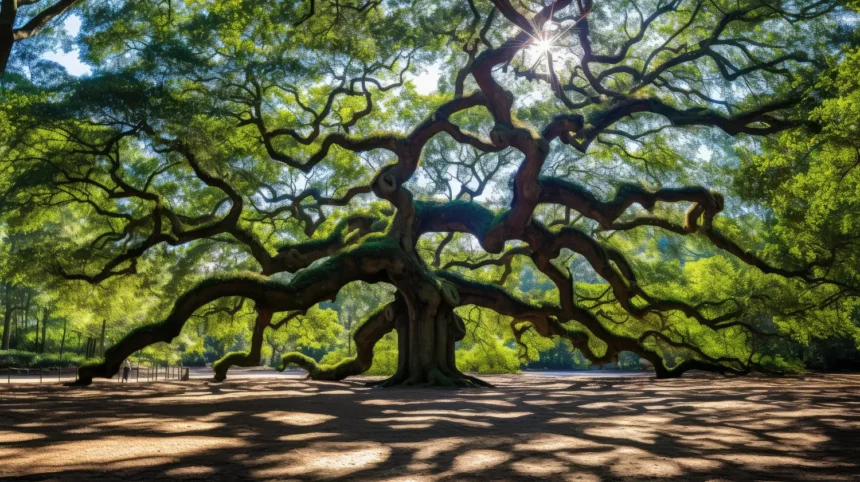Introduction
Nature never runs out of surprises—and trees are some of its most fascinating masterpieces. Across continents and climates, there are unique trees that challenge our understanding of biology, geography, and time itself. Some trees look like they’re painted by artists, while others have evolved forms and survival techniques that science is still studying.
According to the Smithsonian Institution, there are over 73,000 tree species globally, many of which are still undiscovered. Among these, a handful stand out for their rare characteristics, mysterious growth patterns, and cultural legends. Whether it’s a tree that seems to bleed red or one that can live for over 4,800 years, these natural marvels prove why trees are much more than just green canopies.
Let’s take a journey to uncover 15 of the most unique trees in the world—from the twisted trunks of Poland’s Crooked Forest to the vibrant Rainbow Eucalyptus in the Philippines.
Read More: Top 20 Most Beautiful National Forests of America: Where Nature’s Wonders Come Alive
Most Unique Trees in the World
1. Rainbow Eucalyptus – Philippines & Indonesia
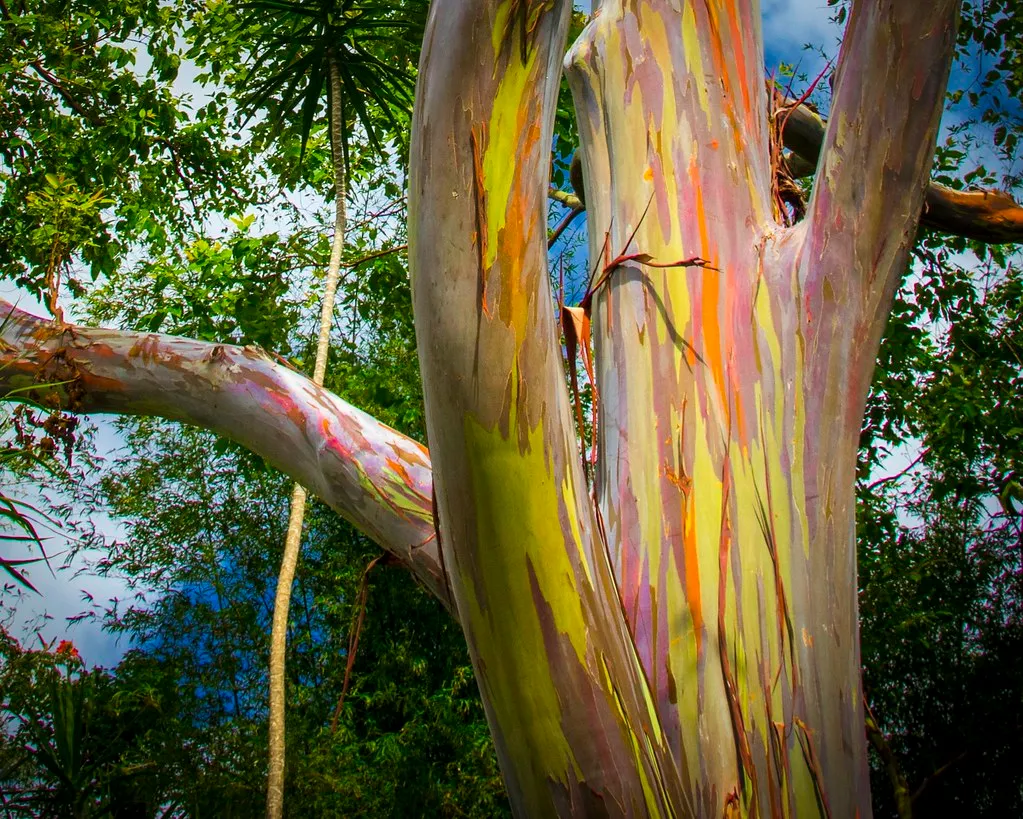
Why It’s Unique
This tropical tree earns its name from the kaleidoscopic colors on its bark. As the outer bark peels away, it reveals layers of green, orange, purple, and maroon underneath.
Botanical Insights
- Scientific Name: Eucalyptus deglupta
- It’s the only eucalyptus species that grows naturally in the Northern Hemisphere.
Cultural & Ecological Significance
Used for pulpwood and paper production, it also attracts eco-tourism and biodiversity interest in the Philippines and Indonesia.
Read More: 10 Mind-Blowing Wonders of Earth’s Great Mountain Ranges and Their Challenges
2. Baobab Trees – Africa & Madagascar
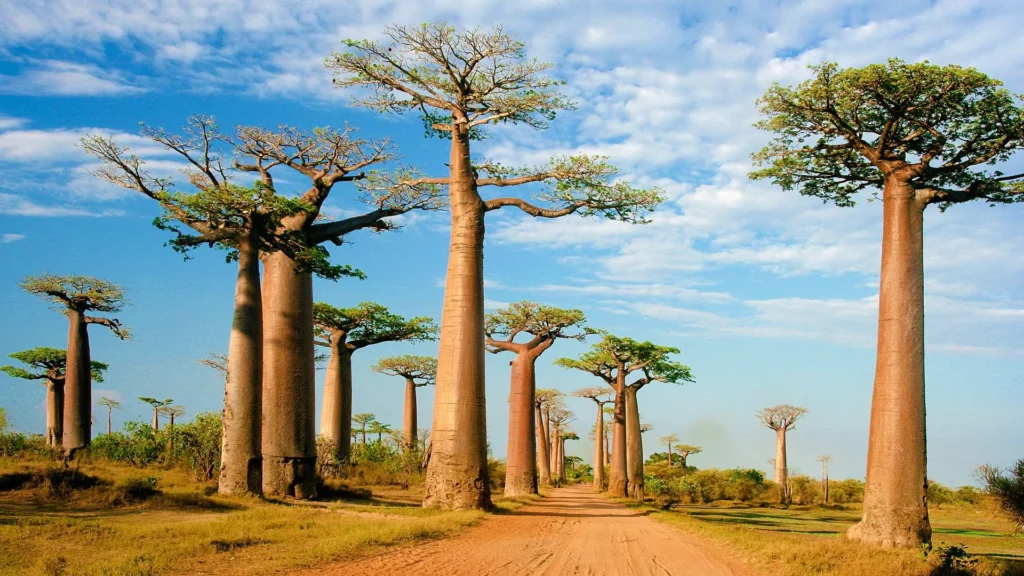
Why It’s Unique
Known as the “Tree of Life,” some baobabs store over 26,000 gallons of water in their massive trunks.
Scientific Update (2024)
A National Geographic report (Feb 2024) warns of severe declines in Baobab populations due to climate change and deforestation in Madagascar.
Fun Fact
The Baobab can live over 2,500 years and looks like it’s been planted upside down.
Read More: Discover Tsingy de Bemaraha: Madagascar’s 100 Miles of Razor-Sharp Stone Wonders
3. Dragon Blood Tree – Socotra, Yemen
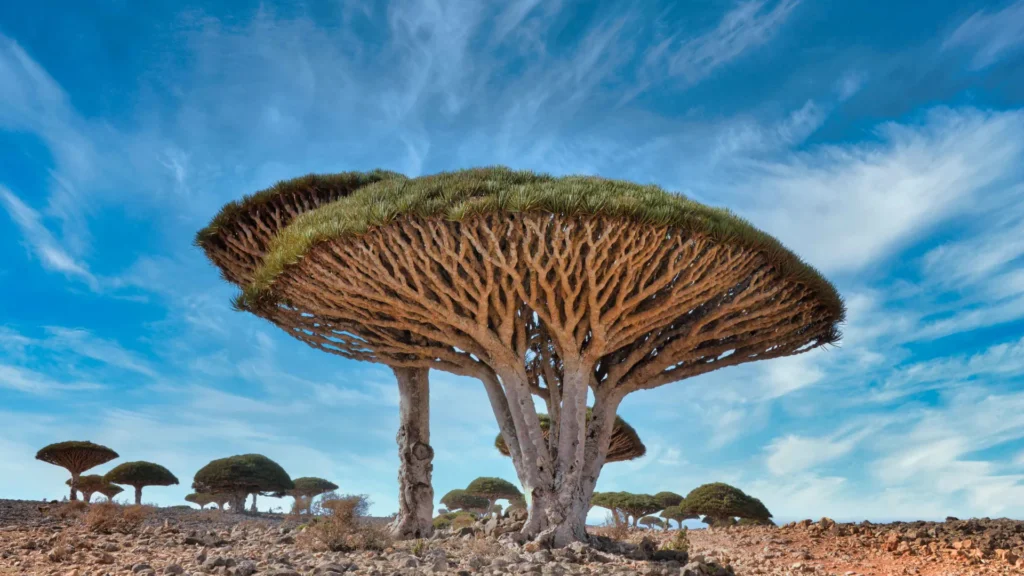
Why It’s Unique
This umbrella-shaped tree oozes dark red sap that was once believed to be dragon’s blood, used in alchemy and medieval medicine.
Ecological Role
Its dense canopy helps capture moisture from fog, critical for the arid environment of Socotra.
Conservation Status
This species is at risk due to habitat loss and climate instability.
Read More: 6 Great Monolithic Rocks of the World: Majestic Wonders of Nature
4. General Sherman – California, USA
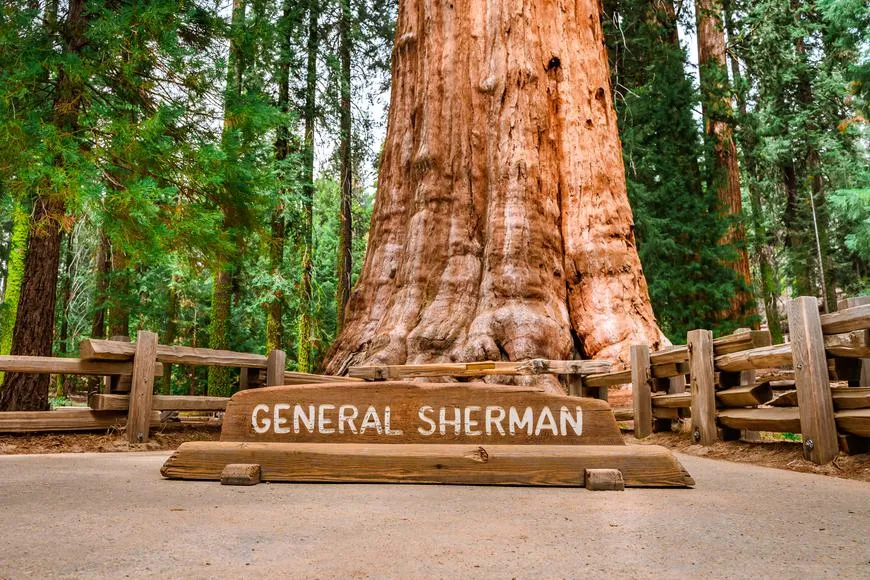
Why It’s Unique
At over 275 feet tall and weighing an estimated 2.7 million pounds, General Sherman is the largest living single-stem tree on Earth.
Location
Located in Sequoia National Park, this giant sequoia is a key part of conservation programs in the USA.
Read More: 5 Geothermal Wonders Around the World You Need to See
5. Tree of Life – Bahrain
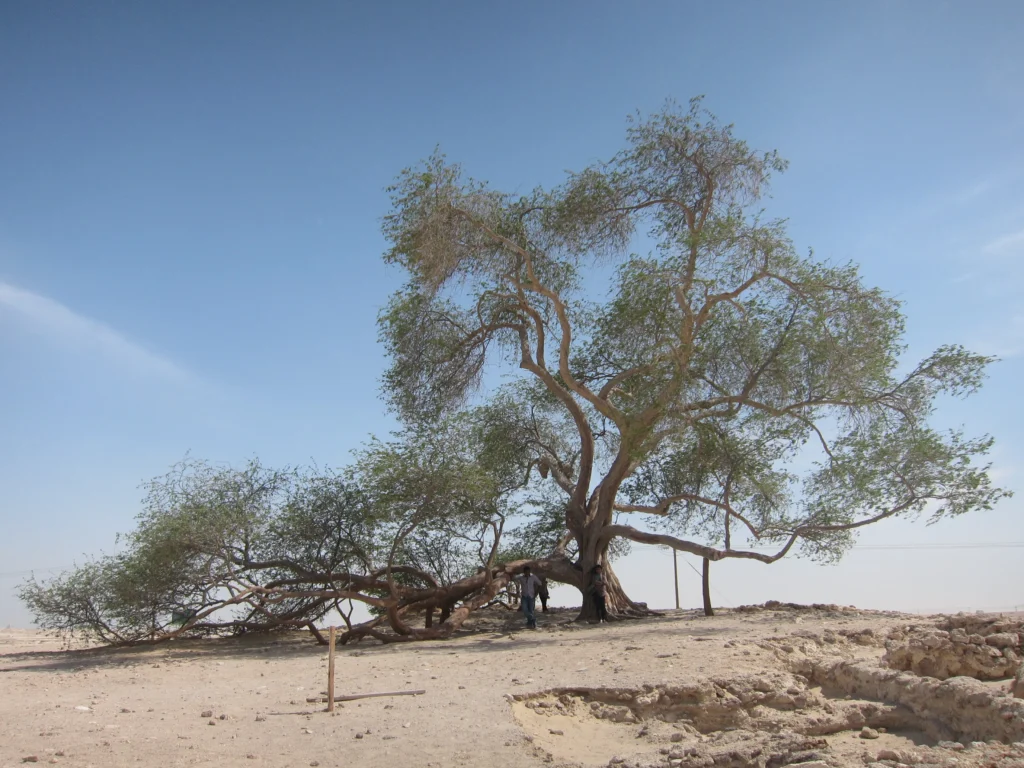
Why It’s Unique
Standing alone in the middle of the desert without any known water source, this Prosopis cineraria has baffled scientists for decades.
Estimated Age
Over 400 years old.
Cultural Significance
Locals believe it marks the location of the Biblical Garden of Eden.
Read More: Door to Hell of Turkmenistan: The Eternal Flame That Defies Time
6. Wisteria Tree – Ashikaga, Japan
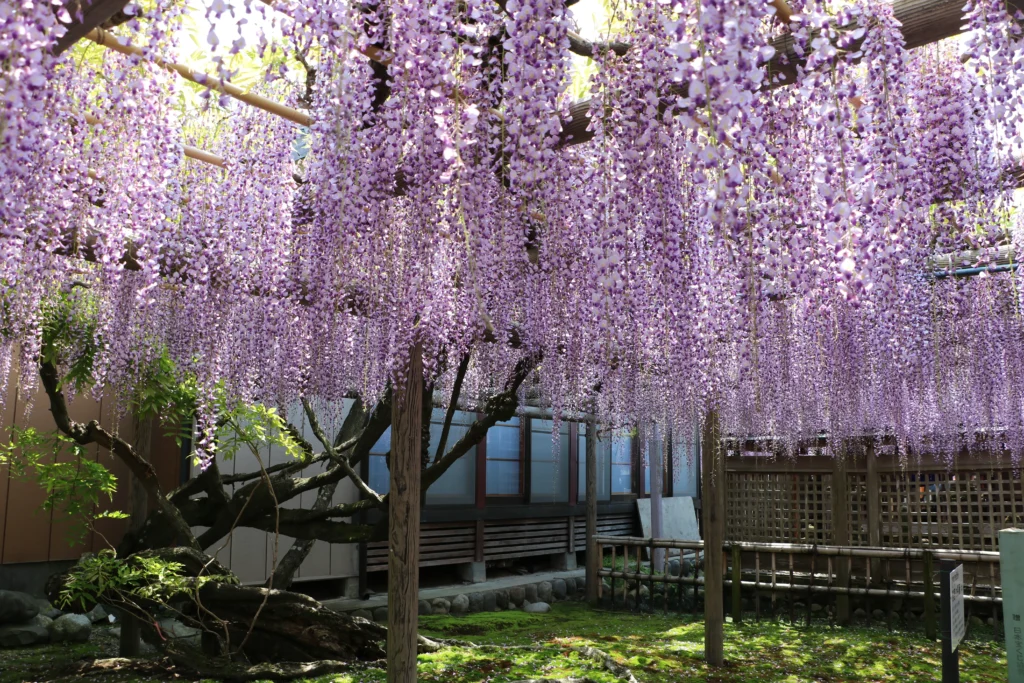
Why It’s Unique
This stunning tree creates a cascading canopy of violet-blue blossoms stretching over 10,000 square feet.
Scientific Note
Though technically a vine, its massive structure and appearance resemble a tree.
Read More: Top 10 Weirdest Looking Natural Structures That Will Blow Your Mind
7. El Árbol del Tule – Oaxaca, Mexico
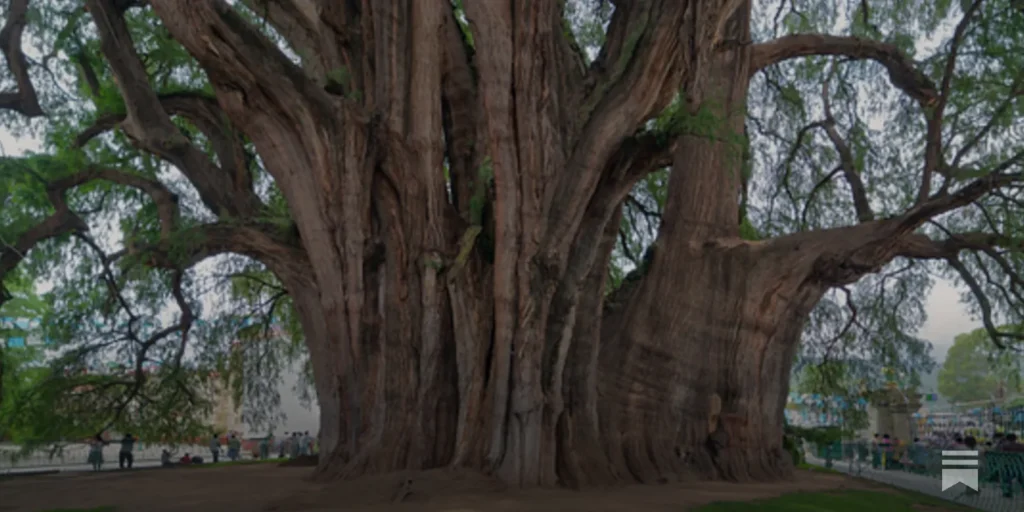
Why It’s Unique
This Montezuma Cypress holds the record for the stoutest tree trunk in the world—over 38 feet in diameter.
Fun Fact
Locals call it the “Tree of Life” for the animal shapes seen in its gnarled trunk.
Read More: 10 Deepest Canyons in the World That Will Leave You in Awe
8. Crooked Forest – Poland
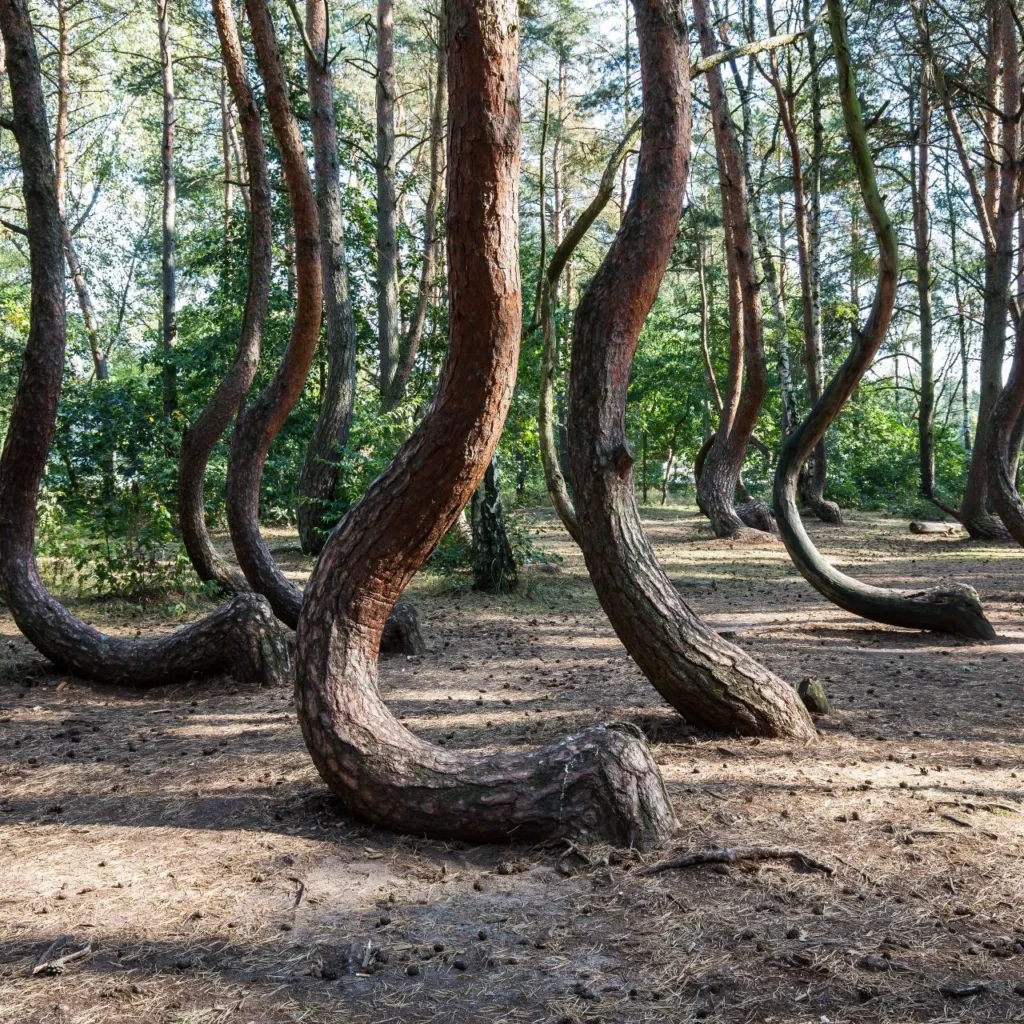
Why It’s Unique
A grove of pine trees that mysteriously grow in J-shaped curves at their bases. The cause is still debated.
Possible Explanations
Snow damage, gravitational pull, or even human intervention in early growth stages.
9. Angel Oak Tree – South Carolina, USA
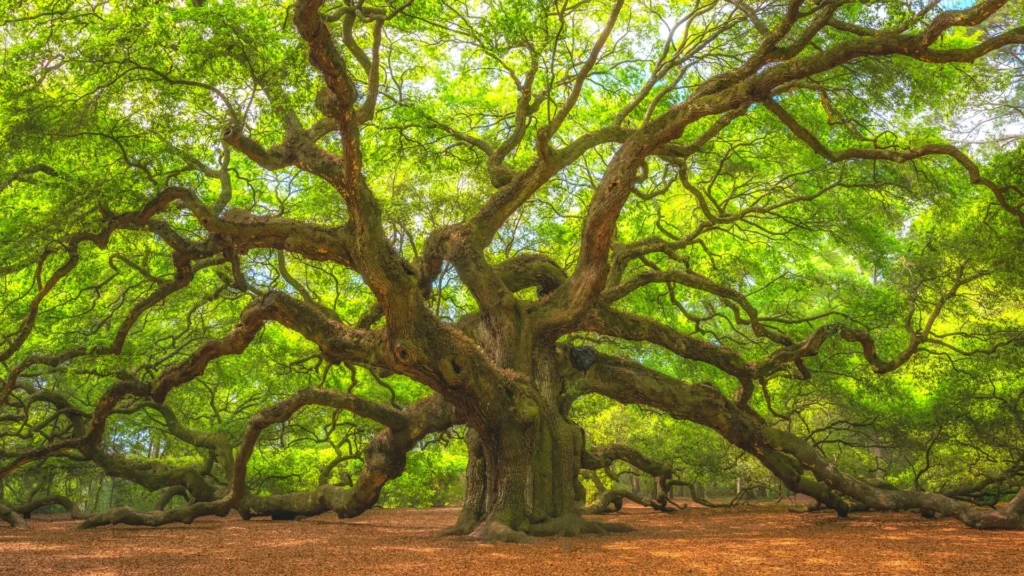
Why It’s Unique
This Southern live oak is over 400 years old, with limbs extending over 187 feet.
Visitor Info
Located in Charleston, it’s a beloved local landmark and tourist spot.
Read More: Hidden Secrets at the Bottom of Lake Tahoe: Know the 4 Unknown Facts
10. Circus Trees – California, USA
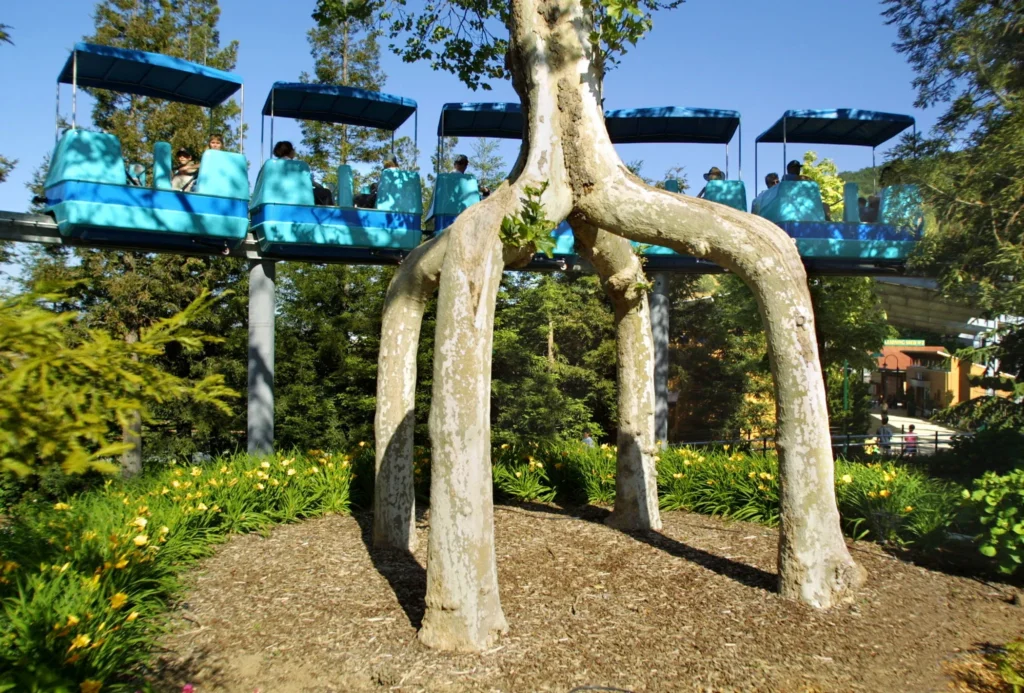
Why It’s Unique
Crafted by human hands, these trees were shaped using grafting and bending techniques to form spirals, loops, and zigzags.
Creator
Axel Erlandson, a farmer and tree enthusiast, designed them as a living art exhibit.
11. Jomon Sugi – Yakushima, Japan
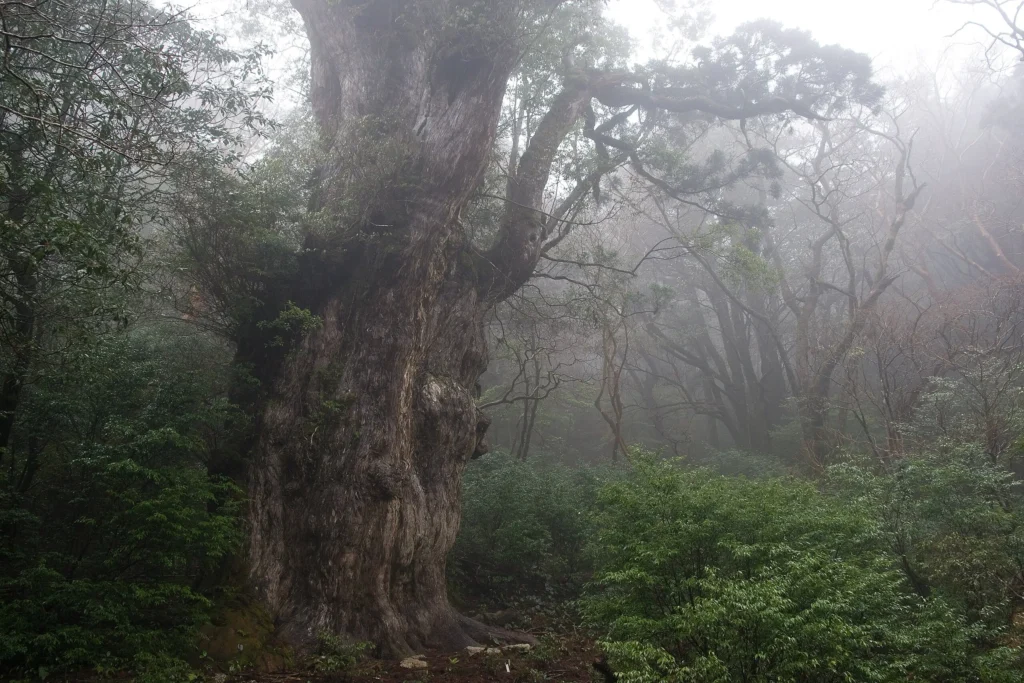
Why It’s Unique
This ancient cedar is estimated to be between 2,000 and 7,200 years old—among the oldest living trees in Japan.
Location
Found in a misty forest on Yakushima Island, a UNESCO World Heritage Site.
12. Silk Cotton Tree – Ta Prohm, Cambodia
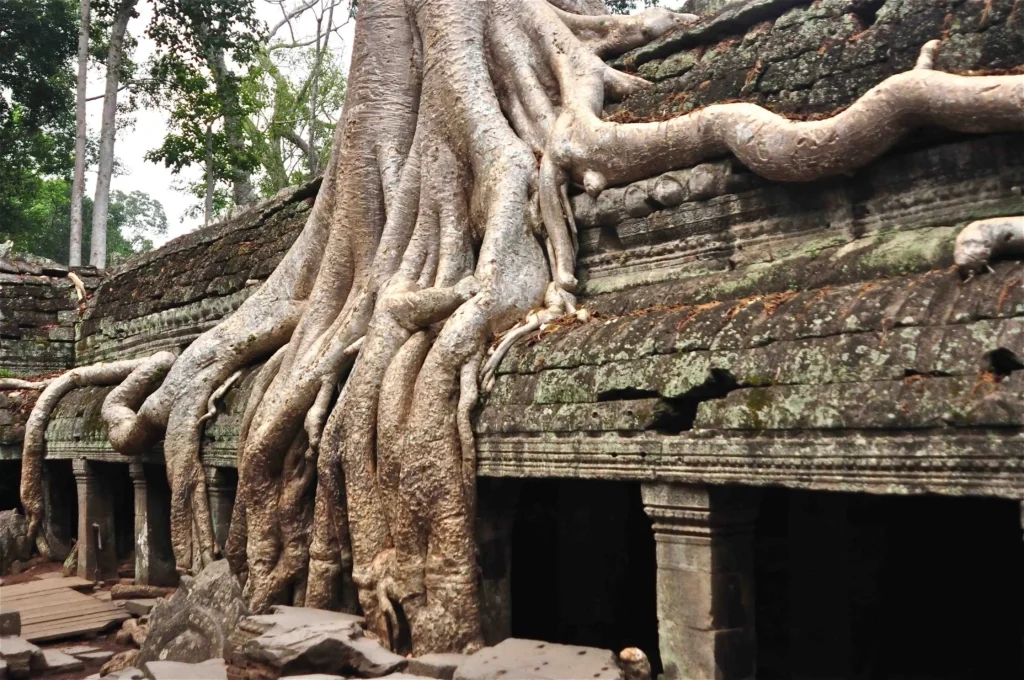
Why It’s Unique
Massive roots of the silk cotton tree engulf the ancient stone temples of Ta Prohm, creating surreal scenery.
Cultural Importance
Featured in the film Tomb Raider, this site blends history, botany, and mythology.
Read More: British Columbia’s Inland Temperate Rainforest: 5 Exclusive Facts
13. Methuselah Tree – California, USA
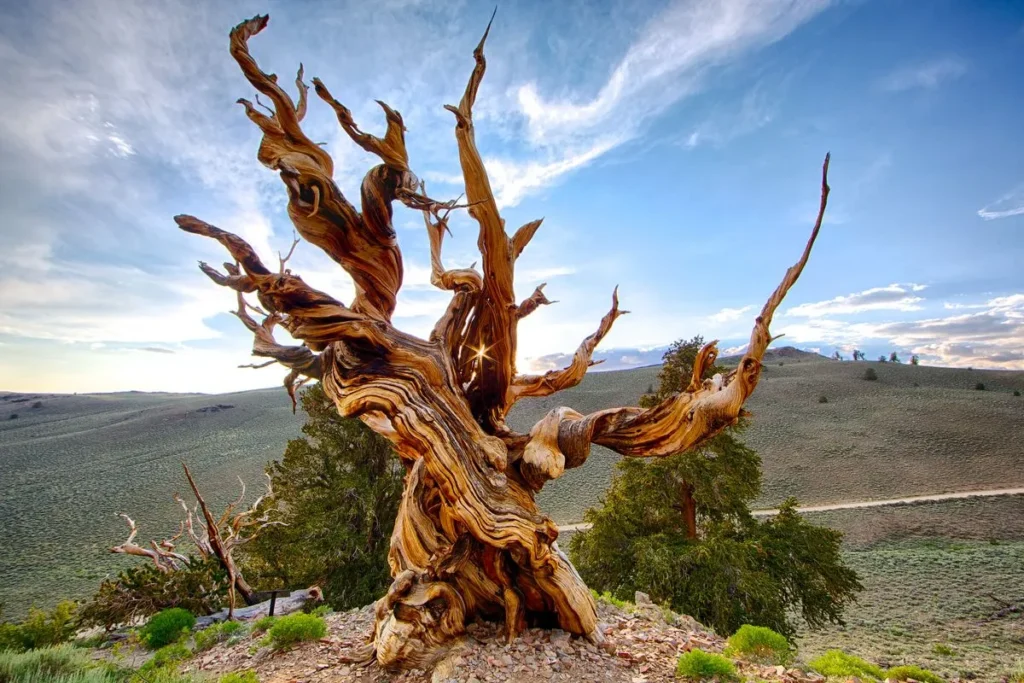
Why It’s Unique
A Bristlecone pine estimated to be over 4,800 years old—the oldest known non-clonal tree on Earth.
Location
In a protected part of the Inyo National Forest. Exact location kept secret for preservation.
14. Walking Palm – Central & South America
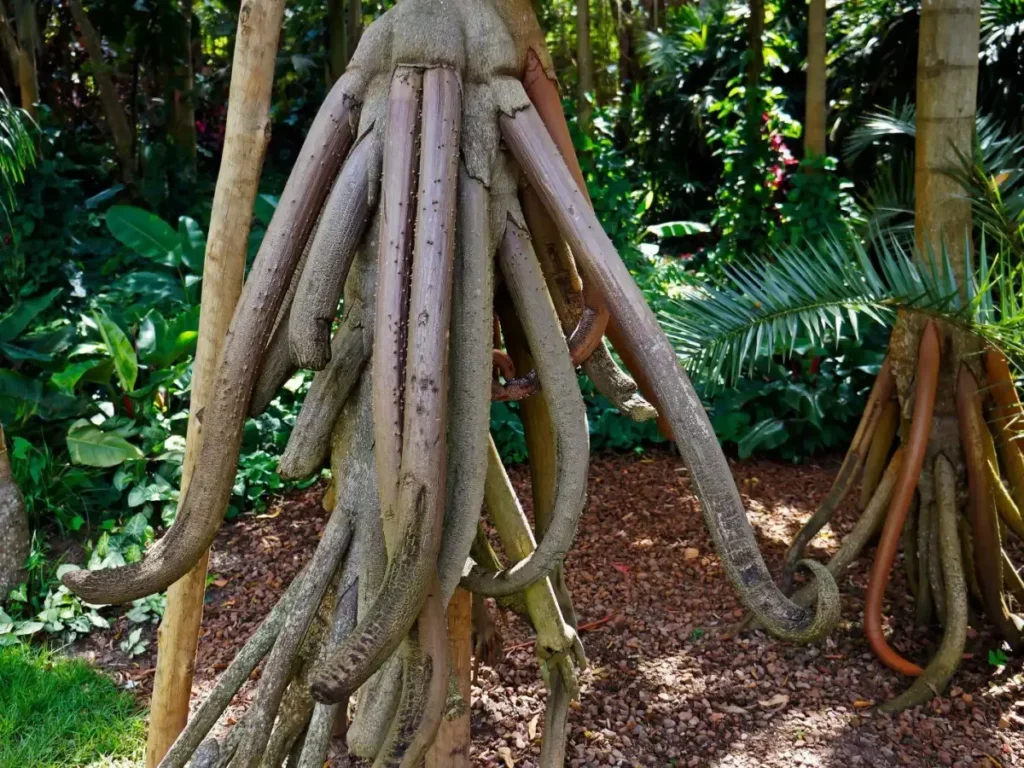
Why It’s Unique
Known for its stilt-like roots, the walking palm appears to “walk” slowly by growing new roots and abandoning old ones.
Scientific Debate
Some botanists question the extent of its movement, but its form is undeniably unusual.
15. Ceiba Tree – Central & South America
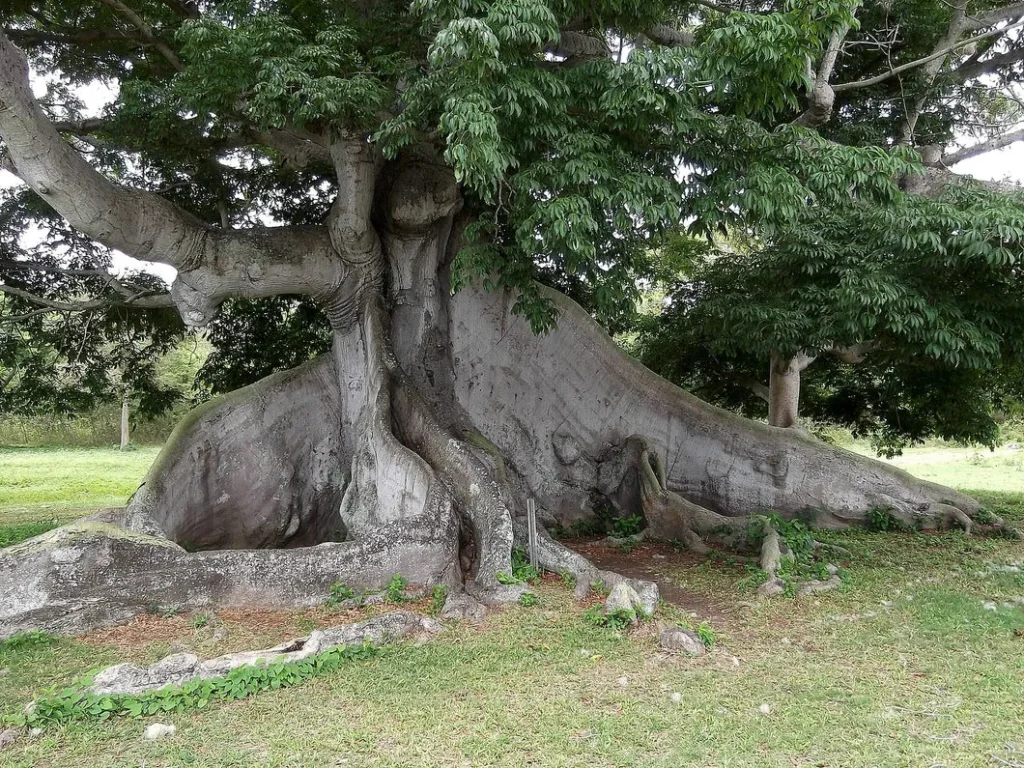
Why It’s Unique
Revered in Mayan and Aztec cultures, the Ceiba tree features an immense trunk, thorny bark, and powerful above-ground roots.
Spiritual and Medicinal Role
Often considered sacred, it appears in mythologies and traditional healing practices across Latin America.
Read More: What’s Inside the Pyramid of Chichén Itzá? 5 Astonishing Secrets Revealed
15 Most Unique Trees in the World
| Tree Name | Estimated Age | Location | Notable Feature |
|---|---|---|---|
| Rainbow Eucalyptus | 50-100 years | Philippines, Indonesia | Multicolored bark |
| Baobab | Up to 2,500 | Africa, Madagascar | Water-storing trunk |
| Dragon Blood Tree | 600+ years | Socotra, Yemen | Red resin resembling blood |
| General Sherman | ~2,200 years | California, USA | Largest biomass of any tree |
| Tree of Life | 400+ years | Bahrain | Survives in desert with no water source |
| Wisteria Tree | ~150 years | Japan | Canopy of cascading violet blossoms |
| El Árbol del Tule | 1,400+ years | Mexico | Widest tree trunk |
| Crooked Forest | ~90 years | Poland | Mysteriously curved pine trees |
| Angel Oak Tree | 400+ years | South Carolina, USA | Gigantic canopy and sprawling limbs |
| Circus Trees | Man-shaped | California, USA | Artistic grafted shapes |
| Jomon Sugi | 2,000–7,200 years | Yakushima, Japan | Japan’s oldest and largest cryptomeria tree |
| Silk Cotton Tree | 100+ years | Cambodia | Roots wrapping ancient temples |
| Methuselah Tree | ~4,800 years | California, USA | Oldest known non-clonal tree |
| Walking Palm | ~100 years | Central/South America | Survives in the desert with no water source |
| Ceiba Tree | 200+ years | Central/South America | Root system gives the appearance of walking |
Importance of Tree Uniqueness in Nature
The importance of these unique trees in the natural world goes far beyond aesthetics. Each of these unique trees plays a critical ecological, cultural, or evolutionary role. By studying rare trees, scientists gain insights into climate resilience, biodiversity patterns, and adaptive traits. Many unusual trees have evolved in isolated ecosystems, which makes them excellent case studies in evolution, geography, and environmental change.
From the weird trees of Socotra to the massive ancient sequoias of California, these botanical wonders help maintain habitats for countless other species. Some store water, some pull nutrients from poor soil, while others act as climate indicators. Their uniqueness also holds symbolic importance for indigenous communities. Preserving them is essential not just for their rarity, but for the biodiversity they support and the stories they carry. These amazing trees in nature remind us how vital each part of the ecosystem truly is.
Appreciating and protecting unique trees isn’t just about wonder—it’s a step toward conserving the planet’s most valuable living systems.
Conclusion
From mythic legends to scientific marvels, the world’s most unique trees teach us how diverse, complex, and vital nature truly is. These unusual trees aren’t just botanical oddities—they are crucial to our ecosystems and cultures. As we explore and protect rare trees, we also safeguard the planet’s future. Whether giant, twisted, sacred, or surreal, each tree reminds us that nature never stops evolving—and neither should our respect for it.
FAQs
1. What makes a tree unique in nature?
Its rarity, growth pattern, size, age, color, or ecological function define a tree’s uniqueness.
2. Which tree is the oldest living non-clonal tree?
The Methuselah Tree in California is over 4,800 years old and still alive today.
3. Are unusual trees endangered?
Yes, many rare trees face threats from climate change, deforestation, and habitat destruction.
4. Can I visit these unique trees around the world?
Most of them are located in national parks or heritage sites and are open for tourism.
5. Why is tree biodiversity important globally?
Tree diversity helps stabilize ecosystems, regulate climate, and support wildlife and human livelihoods.

